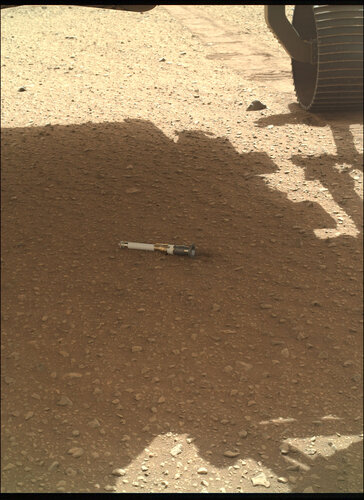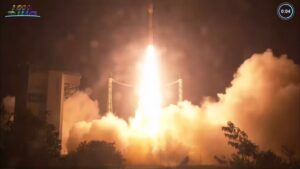South Korean pharma invests $50 million in Axiom Space
Thursday, 22 December 2022 16:36
Boryung, a South Korean pharmaceutical company, has decided to invest $50 million in U.S. commercial space station developer Axiom Space’s Series C funding round.
The post South Korean pharma invests $50 million in Axiom Space appeared first on SpaceNews.
How the Hera asteroid mission will phone home
Thursday, 22 December 2022 15:25
This is the antenna that will transmit back the first close-up images of the distant Dimorphos asteroid since its orbit was shifted by a collision with NASA's DART spacecraft.
The 1.13-m diameter High Gain Antenna of ESA's Hera mission went through a week-long test campaign at the Compact Antenna Test Range, part of the Agency's ESTEC technical center in the Netherlands.
The CATR's metal walls isolate external radio signals while its foam-spike-lined interior absorb radio signals to prevent reflections and reproduce the empty void of space. Each test session took more than 10 hours, with the antenna rotated a degree at a time to build up a 360 degree picture of the antenna's detailed signal shape.
"The High Gain Antenna is really a crucial part of our mission—it will be our sole means of receiving data and sending commands with the volume we need, with the Low Gain Antenna as backup for low data rate emergency communications," explains Hera antenna engineer Victoria Iza.
Hera system engineer Paolo Concari adds, "Coupled with an innovative deep-space transponder, this antenna will also perform science in its own right.
Studies flag environmental impact of reentry
Thursday, 22 December 2022 14:40
The growing scale and pace of launch activities call for more monitoring and regulation to minimize their potential impact on the Earth’s atmosphere.
The post Studies flag environmental impact of reentry appeared first on SpaceNews.
First sample depot on Mars
Thursday, 22 December 2022 13:05 Image:
First sample depot on Mars
Image:
First sample depot on Mars Flight control, space weather and debris: What an astronaut needs to know
Thursday, 22 December 2022 13:00 Video:
00:19:50
Video:
00:19:50
Recently, Andreas Mogensen, now getting ready for his ‘Huginn’ mission to the ISS in 2023, stopped by ESA’s ESOC mission control centre in Darmstadt, Germany, to meet with some of the experts who keep our satellites flying.
Andreas usually works at NASA's Johnson Space Center in Houston as an ISS ‘capcom’, and we don’t often see him in Europe. A few months back, while returning to Germany for some training at ESA’s Astronaut Centre in Cologne, we seized the opportunity to ask him if he’d like to stop over in Darmstadt for a look behind the
China sets out clear and independent long-term vision for space
Thursday, 22 December 2022 12:09
China’s main space contractor is working towards making the country a leading space power with a focus on developing capabilities, space infrastructure and self-reliance.
The post China sets out clear and independent long-term vision for space appeared first on SpaceNews.
Independent panel to investigate Vega C launch failure
Thursday, 22 December 2022 11:56
Arianespace and the European Space Agency will establish an independent commission to investigate the Vega C launch failure Dec. 20 that resulted in the loss of two satellites and new questions about the future of European space access.
Terran Orbital delivers 10 satellite buses to Lockheed Martin for U.S. military constellation
Thursday, 22 December 2022 10:00
Terran Orbital announced Dec. 22 it has completed delivery of 10 satellite buses ordered by Lockheed Martin for the Space Development Agency's mesh network in low Earth orbit.
The post Terran Orbital delivers 10 satellite buses to Lockheed Martin for U.S.
Underground Italian lab searches for signals of quantum gravity
Thursday, 22 December 2022 09:34 For decades physicists have been hunting for a quantum-gravity model that would unify quantum physics, the laws that govern the very small, and gravity. One major obstacle has been the difficulty in testing the predictions of candidate models experimentally. But some of the models predict an effect that can be probed in the lab: a very small violation of a fundamental quantum tenet called the Pa
For decades physicists have been hunting for a quantum-gravity model that would unify quantum physics, the laws that govern the very small, and gravity. One major obstacle has been the difficulty in testing the predictions of candidate models experimentally. But some of the models predict an effect that can be probed in the lab: a very small violation of a fundamental quantum tenet called the Pa Chinese space-tracking ship sets sail for new missions
Thursday, 22 December 2022 09:34North Korea claims spy satellite progress, posts imagery of Seoul, Incheon
Thursday, 22 December 2022 09:34 North Korea claimed Monday to have taken satellite photos of the South Korean cities of Seoul and Incheon, as its state media boasted of success toward developing its first military spy satellite.
The state-run Korean Central News Agency (KCNA) reported an "important final-stage test" involving a mock satellite that it said was launched Sunday from the Sohae Satellite Launching Station in
North Korea claimed Monday to have taken satellite photos of the South Korean cities of Seoul and Incheon, as its state media boasted of success toward developing its first military spy satellite.
The state-run Korean Central News Agency (KCNA) reported an "important final-stage test" involving a mock satellite that it said was launched Sunday from the Sohae Satellite Launching Station in Christmas craterscape
Thursday, 22 December 2022 09:00
This beautifully crisp icy scene with a swirling ribbon of rusty red and white striped terrain connecting two large craters wraps up the year on Mars.
Northrop Grumman space navigation systems achieve galactic threshold
Thursday, 22 December 2022 07:42 When considering that a full calendar year has 8,760 hours and a commercial airliner can be in service for about 30 years (or around 165,000 flying hours), then achieving a continuous performance milestone of 65 million hours is truly out of this world - exactly where Northrop Grumman navigation technology has been operating for decades.
In 2022, Northrop Grumman's hemispherical resonator
When considering that a full calendar year has 8,760 hours and a commercial airliner can be in service for about 30 years (or around 165,000 flying hours), then achieving a continuous performance milestone of 65 million hours is truly out of this world - exactly where Northrop Grumman navigation technology has been operating for decades.
In 2022, Northrop Grumman's hemispherical resonator UK space regulator issues Virgin Orbit licenses ahead of UK launch
Thursday, 22 December 2022 07:42 The UK Civil Aviation Authority has issued the final remaining licences to Virgin Orbit ahead of a planned UK launch after requirements were met within 15 months. The licences were issued following consent from Transport Secretary Mark Harper for Virgin Orbit's launch and range licence, meaning he is in agreement with the licensing decisions made by the UK Civil Aviation Authority.
Virgin
The UK Civil Aviation Authority has issued the final remaining licences to Virgin Orbit ahead of a planned UK launch after requirements were met within 15 months. The licences were issued following consent from Transport Secretary Mark Harper for Virgin Orbit's launch and range licence, meaning he is in agreement with the licensing decisions made by the UK Civil Aviation Authority.
Virgin Exploration power for the Moon, Mars, and Beyond
Thursday, 22 December 2022 07:42 With Artemis, NASA looks to accomplish something unprecedented - exploration of the lunar South Pole. When astronauts reach their destination and establish a long-term presence, a unique challenge awaits.
Unlike Apollo missions, which were equatorial and had abundant sunlight, Artemis missions will operate in inhospitable conditions, including the lunar night cycle and permanently shadowed
With Artemis, NASA looks to accomplish something unprecedented - exploration of the lunar South Pole. When astronauts reach their destination and establish a long-term presence, a unique challenge awaits.
Unlike Apollo missions, which were equatorial and had abundant sunlight, Artemis missions will operate in inhospitable conditions, including the lunar night cycle and permanently shadowed 
